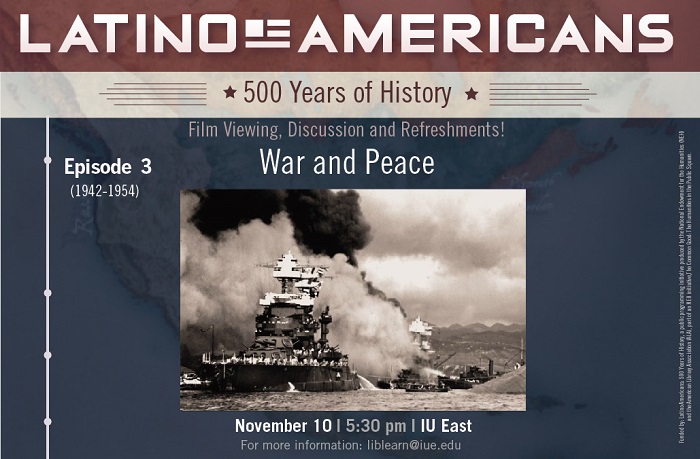IU East hosts two film screenings in November, as part of the Latino Americans: 500 Years of History series. The November 10 discussion will be led by Dr. Katherine Miller, Assistant Professor of Anthropology. On November 17, discussion will be facilitated by IU East students Nate Pendergraft, president of the history club, and Katelyn Brown, of the World Languages and Cultures Club
Both screenings are in the “Back Stacks” area of the Campus Library and begin at 5:30 p.m. Refreshments will be served. All are welcome!
November 10 – War and Peace (1942-1954)
http://iue.libguides.com/latinoamericans/episode3
Throughout World War II Latino Americans fought alongside Anglos. In the Pacific, East Los Angelos’ Guy Gabaldon became a Marine Corps legend when he singlehandedly captured more enemy soldiers than anyone in US military history. But on the home front, discrimination is rampant; in 1943, Anglo servicemen battle hip young “Zoot suitors” in racially charged riots in southern California.
After the war, Macario Garcia becomes the first Mexican National to earn the Congressional Medal of Honor for his exploits fighting in Europe, only to be refused service in a Texas diner. The experience during the war pushes Latinos to fight for civil rights back home. A doctor from South Texas, Hector Garcia, organizes the American GI Forum, becoming an advocate for civil rights. Although Latinos make significant gains, the journey for equality is far from over.
November 17 The New Latinos (1946-1965)
http://iue.libguides.com/latinoamericans/episode4
Until World War II, Latino immigration to the United States was overwhelmingly Mexican-American. Three new waves bring large-scale immigration from Puerto Rico, Cuba, and the Dominican Republic. As the Puerto Rican government implements a historic overhaul, more than a million Puerto Ricans are encouraged to leave for the U.S. mainland to alleviate economic pressure. A young Juanita Sanabria arrives in New York, works hard in the garment district, but encounters hostility and discrimination. Ethnic tensions explode in youth gang warfare depicted in films like West Side Story, etching the stereotype of the knife wielding Puerto Rican in the American consciousness.
In the early 1960s, the first Cubans flee the left-wing Castro regime, a relatively white, middle-class flight that soon forms a refugee enclave in Miami. A child of 11 at the time, Gustavo Perez Firmat believes, like most refugees, that it is only a matter of weeks before the American government will wrest Cuba from the Communist regime. But Castro survives. Maria de los Angeles Torres is only six years old when she leaves Havana without her parents, one of 14,000 children who are smuggled out through an underground network. Unable to leave legally, Manuel Capo and his two military age sons make a dramatic journey to the US. With skills honed in the family furniture business in Cuba and support from the federal government, the Capos build a thriving business marketing to the growing Cuban population.
In 1965, fearing another Communist takeover in the Caribbean, President Johnson sends Marines to the Dominican Republic, triggering a third wave of immigration. With a US visa in hand, 20 year-old university student Eligio Peña, flees to New York. Eventually, he brings his family to New York as Dominicans build a new home in Washington Heights. Julia Alvarez would take the immigrant experience – her own and that of her fellow Dominicans – to unprecedented literary heights in How the Garcia Girls Lost Their Accents. In her work, she explores the hybrid identity taking shape in a new generation of Latinos, who are now demanding their place in America.
Funding credit: Latino Americans: 500 Years of History, a public programming initiative produced by the National Endowment for the Humanities (NEH) & the American Library Association, is part of an NEH initiative, The Common Good: The Humanities in the Public Square



